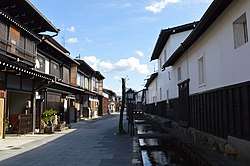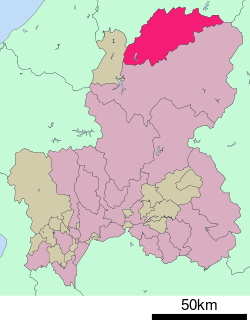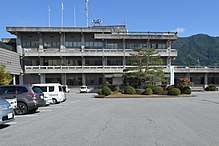Hida, Gifu
Hida (飛騨市, Hida-shi) is a city located in Gifu, Japan. As of 1 December 2017, the city had an estimated population of 24,726, and a population density of 31 persons per km2, in 8,905 households.[1] The total area of the city was 792.53 square kilometres (306.00 sq mi). The official kanji for the city is actually 飛驒, which uses the old (kyūjitai) rendering of the 騨 character. However, the 驒 character is not included on the official list of usable characters (as decided by the Ministry of Internal Affairs and Communications), so the 騨 character is often used outside of the city.
Hida 飛騨市 | |
|---|---|
 View of Hida old town | |
 Flag Seal | |
 Location of Hida in Gifu Prefecture | |
 Hida | |
| Coordinates: 36°14′17.3″N 137°11′10.4″E | |
| Country | Japan |
| Region | Chūbu |
| Prefecture | Gifu |
| Area | |
| • Total | 792.53 km2 (306.00 sq mi) |
| Population (November 1, 2017) | |
| • Total | 24,726 |
| • Density | 31/km2 (81/sq mi) |
| Time zone | UTC+9 (Japan Standard Time) |
| City symbols | |
| - Tree | Beech |
| - Flower | Lysichiton camtschatcense |
| Phone number | 0577-73-2111 |
| Address | 2-22 Hon-machi, Furukawa-chō, Hida-shi, Gifu-ken 509-4292 |
| Website | Official website |



Geography
Hida is the northernmost city in Gifu Prefecture, and is located in the northern part of the Hida Highlands bordering on Toyama Prefecture to the north. The majority of the area of the city is forested, with many mountains exceeding 1,000 meters within the city borders. The northeastern edge of the Hida Mountain range exceeds 2,000 meters. Most of the population is concentrated along river terraces along the Jinzū River and the Takahara River.
Geographic Importance
The area surrounding Hida has direct connection with the Hida belt. The Hida belt mainly const of a younger type-1 granite and older type-2 granite. It has been studied that the Hida Belt has separated from the Jiamushi massif, that is located in the eastern margin of the Central Asian Orogenic Belt. After looking into geochronological data and several other data forms it is suggested that the Hida Belt broke off the Central Asian Orogenic Belt.[2]
Climate
The city has a climate characterized by hot and humid summers, and mild winters (Köppen climate classification Cfa). The average annual temperature in Hida is 11.5 °C. The average annual rainfall is 1949 mm with September as the wettest month. The temperatures are highest on average in August, at around 24.6 °C, and lowest in January, at around -1.1 °C.[3]
Neighbouring municipalities
- Gifu Prefecture
- Toyama Prefecture
Demographics
Per Japanese census data,[4] the population of Hida has decreased steadily over the past 40 years.
| Census Year | Population |
|---|---|
| 1970 | 40,965 |
| 1980 | 36,100 |
| 1990 | 32,690 |
| 2000 | 30,421 |
| 2010 | 26,732 |
| 2018 | 23,439 |
History
The area around Hida was part of traditional Hida Province. During the Edo period, the area was tenryō territory under the direct control of the Tokugawa shogunate. During the post-Meiji restoration cadastral reforms, the area was organised into Yoshiki District, Gifu. On July 1, 1889 with the establishment of the modern municipalities system, town of Furukawa and the villages of Kawai and Miyagawa were created. The modern city of Hida was established on February 1, 2004, from the merger of these municipalities with the town of Kamioka.
Government
Hida has a mayor-council form of government with a directly elected mayor and a unicameral city legislature of 14 members
Economy
The main two traditional economies in the city are the production of sake and traditional Japanese candles. The Furukawa area of the city is known for both of these crafts, while the Kamioka section is mainly known for its sake production.
Education
Hida has five public elementary schools, two public middle schools and one combined elementary/middle school operated by the city government. The city has two public high schools operated by the Gifu Prefectural Board of Education. Tokyo University's Super-Kamiokande neutrino observatory together with the data processing centre (Kamioka Observatory) has been located in Kamioka since 2002.[5]
Transportation
Railway
- Hida-Furukawa - Sugisaki - Hida-Hosoe - Tsunogawa - Sakakami - Utsubo - Sugihara
Highway
- E41 Tōkai-Hokuriku Expressway, which connects the cities of Nagoya and Gifu with Toyama.




Sister city relations

.svg.png)

Local attractions
Festivals in Hida
Furukawa Festival, a famous festival in Gifu Prefecture, is held every April.[6]
Folk Customs Museum
Local museum in Takayama, Gifu Prefecture shows folk culture of the area. The main purpose of this museum is the preservation of farmhouses from Shirakawa, Gifu (village). These buildings were exclusive to Japan and were made to house large families. Having historical farmhouses as the main attraction for this museum put Japanese culture and history as a tourist attraction.[7] The Folk Customs Museum is a center of tourism in the area and in 1988 averaged more than 2,000 visitors a day.[8] Rural heritage and cultural history is an important viewing for tourist.Takayama is a main tourist destination and is trying to account for more of Japan's tourism market. Being a historical town in a mountain location it is an ideal location to grow and expand for tourism.[9]
Popular culture
Kimi no Na Wa
Hida Furukawa was featured in several key locations in the popular 2016 animated film, Kimi no Na Wa (君の名は, Your Name). Due to the film's popularity, the city has become a popular location for tourists.[10]
References
- Official city statistics page
- Zhao, Xilin (2013). New SHRIMP U–Pb Zircon Ages of Granitic Rocks in the Hida Belt, Japan: Implications for Tectonic Correlation with Jiamushi Massif. pp. 508–521.
- Hida climate data
- Hida population statistics
- http://www.mindat.org/loc-2199.html
- "Furukawa Festival". Archived from the original on February 2, 2017. Retrieved January 31, 2017.
- Eder, Matthias (Winter 2018). "The Folk Customs Museum in Takayama (Hida, Gifu Prefecture)". Asian Folklore Studies. 31 (2): 141–148. doi:10.2307/1177491. JSTOR 1177491.
- Ehrentraut, Adolf (Winter 2019). "Heritage Authenticity and Domestic Tourism in Japan". Annals of Tourism Research. 20 (2): 262–278. doi:10.1016/0160-7383(93)90054-7.
- Funck, Carolin (Winter 2018). "The Innovative Potential of Inbound Tourism in Japan for Destination Development − a Case Study of Hida Takayama". Journal of the German Institute for Japanese Studies Tokyo. 24 (2): 121–147. doi:10.1515/cj-2012-0007.
- Mike (2016-11-26). "City that inspired settings in hit anime "Your Name" sees unbelievable boost in tourist dollars". SoraNews. Retrieved 24 February 2019.
External links
| Wikivoyage has a travel guide for Hida. |

- Hida City official website (Japanese, English, Korean and Chinese)